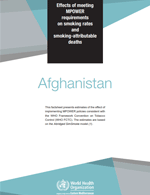
Afghanistan: Effects of meeting MPOWER requirements on smoking rates and smoking-attributable deaths
Publication date: 2018
This country factsheet presents estimates of the effect of implementing MPOWER policies consistent with the WHO Framework Convention on Tobacco Control (WHO FCTC). The estimates are based on the Abridged SimSmoke model. The Abridged SimSmoke model has been used to show the number of deaths from smoking and how implementation of MPOWER policies - tax increases accompanied by smoke-free laws, comprehensive marketing restrictions, comprehensive cessation programmes, strong health warnings and mass media campaigns - can reduce smoking prevalence by 2025, thus meeting the global target of a 30% reduction.
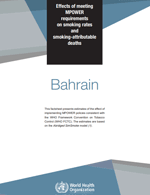
Bahrain: Effects of meeting MPOWER requirements on smoking rates and smoking-attributable deaths
Publication date: 2018
This country factsheet presents estimates of the effect of implementing MPOWER policies consistent with the WHO Framework Convention on Tobacco Control (WHO FCTC). The estimates are based on the Abridged SimSmoke model. The Abridged SimSmoke model has been used to show the number of deaths from smoking and how implementation of MPOWER policies - tax increases accompanied by smoke-free laws, comprehensive marketing restrictions, comprehensive cessation programmes, strong health warnings and mass media campaigns - can reduce smoking prevalence by 2025, thus meeting the global target of a 30% reduction.
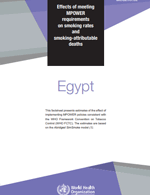
Egypt: Effects of meeting MPOWER requirements on smoking rates and smoking-attributable deaths
Publication date: 2018
This country factsheet presents estimates of the effect of implementing MPOWER policies consistent with the WHO Framework Convention on Tobacco Control (WHO FCTC). The estimates are based on the Abridged SimSmoke model. The Abridged SimSmoke model has been used to show the number of deaths from smoking and how implementation of MPOWER policies - tax increases accompanied by smoke-free laws, comprehensive marketing restrictions, comprehensive cessation programmes, strong health warnings and mass media campaigns - can reduce smoking prevalence by 2025, thus meeting the global target of a 30% reduction.
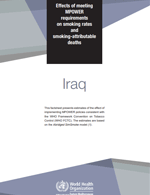
Iraq: Effects of meeting MPOWER requirements on smoking rates and smoking-attributable deaths
Publication date: 2018
This country factsheet presents estimates of the effect of implementing MPOWER policies consistent with the WHO Framework Convention on Tobacco Control (WHO FCTC). The estimates are based on the Abridged SimSmoke model. The Abridged SimSmoke model has been used to show the number of deaths from smoking and how implementation of MPOWER policies - tax increases accompanied by smoke-free laws, comprehensive marketing restrictions, comprehensive cessation programmes, strong health warnings and mass media campaigns - can reduce smoking prevalence by 2025, thus meeting the global target of a 30% reduction.
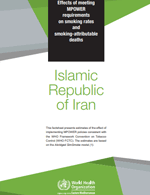
Islamic Republic of Iran: Effects of meeting MPOWER requirements on smoking rates and smoking-attributable deaths
Publication date: 2018
This country factsheet presents estimates of the effect of implementing MPOWER policies consistent with the WHO Framework Convention on Tobacco Control (WHO FCTC). The estimates are based on the Abridged SimSmoke model. The Abridged SimSmoke model has been used to show the number of deaths from smoking and how implementation of MPOWER policies - tax increases accompanied by smoke-free laws, comprehensive marketing restrictions, comprehensive cessation programmes, strong health warnings and mass media campaigns - can reduce smoking prevalence by 2025, thus meeting the global target of a 30% reduction.
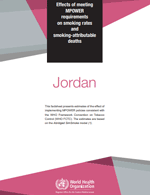
Jordan: Effects of meeting MPOWER requirements on smoking rates and smoking-attributable deaths
Publication date: 2018
This country factsheet presents estimates of the effect of implementing MPOWER policies consistent with the WHO Framework Convention on Tobacco Control (WHO FCTC). The estimates are based on the Abridged SimSmoke model. The Abridged SimSmoke model has been used to show the number of deaths from smoking and how implementation of MPOWER policies - tax increases accompanied by smoke-free laws, comprehensive marketing restrictions, comprehensive cessation programmes, strong health warnings and mass media campaigns - can reduce smoking prevalence by 2025, thus meeting the global target of a 30% reduction.
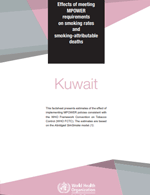
Kuwait: Effects of meeting MPOWER requirements on smoking rates and smoking-attributable deaths
Publication date: 2018
This country factsheet presents estimates of the effect of implementing MPOWER policies consistent with the WHO Framework Convention on Tobacco Control (WHO FCTC). The estimates are based on the Abridged SimSmoke model. The Abridged SimSmoke model has been used to show the number of deaths from smoking and how implementation of MPOWER policies - tax increases accompanied by smoke-free laws, comprehensive marketing restrictions, comprehensive cessation programmes, strong health warnings and mass media campaigns - can reduce smoking prevalence by 2025, thus meeting the global target of a 30% reduction.
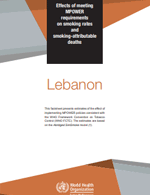
Lebanon: Effects of meeting MPOWER requirements on smoking rates and smoking-attributable deaths
Publication date: 2018
This country factsheet presents estimates of the effect of implementing MPOWER policies consistent with the WHO Framework Convention on Tobacco Control (WHO FCTC). The estimates are based on the Abridged SimSmoke model. The Abridged SimSmoke model has been used to show the number of deaths from smoking and how implementation of MPOWER policies - tax increases accompanied by smoke-free laws, comprehensive marketing restrictions, comprehensive cessation programmes, strong health warnings and mass media campaigns - can reduce smoking prevalence by 2025, thus meeting the global target of a 30% reduction.
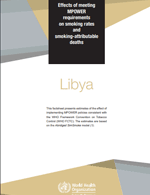
Libya: Effects of meeting MPOWER requirements on smoking rates and smoking-attributable deaths
Publication date: 2018
This country factsheet presents estimates of the effect of implementing MPOWER policies consistent with the WHO Framework Convention on Tobacco Control (WHO FCTC). The estimates are based on the Abridged SimSmoke model. The Abridged SimSmoke model has been used to show the number of deaths from smoking and how implementation of MPOWER policies - tax increases accompanied by smoke-free laws, comprehensive marketing restrictions, comprehensive cessation programmes, strong health warnings and mass media campaigns - can reduce smoking prevalence by 2025, thus meeting the global target of a 30% reduction.
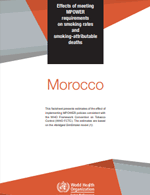
Morocco: Effects of meeting MPOWER requirements on smoking rates and smoking-attributable deaths
Publication date: 2018
This country factsheet presents estimates of the effect of implementing MPOWER policies consistent with the WHO Framework Convention on Tobacco Control (WHO FCTC). The estimates are based on the Abridged SimSmoke model. The Abridged SimSmoke model has been used to show the number of deaths from smoking and how implementation of MPOWER policies - tax increases accompanied by smoke-free laws, comprehensive marketing restrictions, comprehensive cessation programmes, strong health warnings and mass media campaigns - can reduce smoking prevalence by 2025, thus meeting the global target of a 30% reduction.
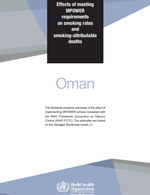
Oman: Effects of meeting MPOWER requirements on smoking rates and smoking-attributable deaths
Publication date: 2018
This country factsheet presents estimates of the effect of implementing MPOWER policies consistent with the WHO Framework Convention on Tobacco Control (WHO FCTC). The estimates are based on the Abridged SimSmoke model. The Abridged SimSmoke model has been used to show the number of deaths from smoking and how implementation of MPOWER policies - tax increases accompanied by smoke-free laws, comprehensive marketing restrictions, comprehensive cessation programmes, strong health warnings and mass media campaigns - can reduce smoking prevalence by 2025, thus meeting the global target of a 30% reduction.
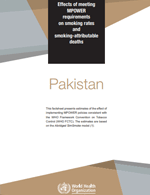
Pakistan: Effects of meeting MPOWER requirements on smoking rates and smoking-attributable deaths
Publication date: 2018
This country factsheet presents estimates of the effect of implementing MPOWER policies consistent with the WHO Framework Convention on Tobacco Control (WHO FCTC). The estimates are based on the Abridged SimSmoke model. The Abridged SimSmoke model has been used to show the number of deaths from smoking and how implementation of MPOWER policies - tax increases accompanied by smoke-free laws, comprehensive marketing restrictions, comprehensive cessation programmes, strong health warnings and mass media campaigns - can reduce smoking prevalence by 2025, thus meeting the global target of a 30% reduction.
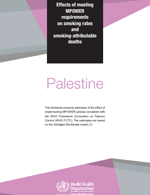
Palestine: Effects of meeting MPOWER requirements on smoking rates and smoking-attributable deaths
Publication date: 2018
This country factsheet presents estimates of the effect of implementing MPOWER policies consistent with the WHO Framework Convention on Tobacco Control (WHO FCTC). The estimates are based on the Abridged SimSmoke model. The Abridged SimSmoke model has been used to show the number of deaths from smoking and how implementation of MPOWER policies - tax increases accompanied by smoke-free laws, comprehensive marketing restrictions, comprehensive cessation programmes, strong health warnings and mass media campaigns - can reduce smoking prevalence by 2025, thus meeting the global target of a 30% reduction.
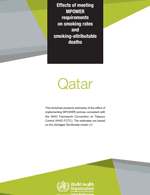
Qatar: Effects of meeting MPOWER requirements on smoking rates and smoking-attributable deaths
Publication date: 2018
This country factsheet presents estimates of the effect of implementing MPOWER policies consistent with the WHO Framework Convention on Tobacco Control (WHO FCTC). The estimates are based on the Abridged SimSmoke model. The Abridged SimSmoke model has been used to show the number of deaths from smoking and how implementation of MPOWER policies - tax increases accompanied by smoke-free laws, comprehensive marketing restrictions, comprehensive cessation programmes, strong health warnings and mass media campaigns - can reduce smoking prevalence by 2025, thus meeting the global target of a 30% reduction.
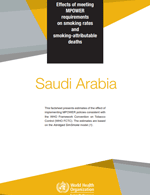
Saudi Arabia: Effects of meeting MPOWER requirements on smoking rates and smoking-attributable deaths
Publication date: 2018
This country factsheet presents estimates of the effect of implementing MPOWER policies consistent with the WHO Framework Convention on Tobacco Control (WHO FCTC). The estimates are based on the Abridged SimSmoke model. The Abridged SimSmoke model has been used to show the number of deaths from smoking and how implementation of MPOWER policies - tax increases accompanied by smoke-free laws, comprehensive marketing restrictions, comprehensive cessation programmes, strong health warnings and mass media campaigns - can reduce smoking prevalence by 2025, thus meeting the global target of a 30% reduction.
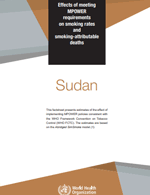
Sudan: Effects of meeting MPOWER requirements on smoking rates and smoking-attributable deaths
Publication date: 2018
This country factsheet presents estimates of the effect of implementing MPOWER policies consistent with the WHO Framework Convention on Tobacco Control (WHO FCTC). The estimates are based on the Abridged SimSmoke model. The Abridged SimSmoke model has been used to show the number of deaths from smoking and how implementation of MPOWER policies - tax increases accompanied by smoke-free laws, comprehensive marketing restrictions, comprehensive cessation programmes, strong health warnings and mass media campaigns - can reduce smoking prevalence by 2025, thus meeting the global target of a 30% reduction.
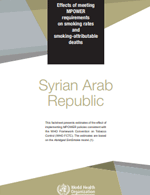
Syrian Arab Republic: Effects of meeting MPOWER requirements on smoking rates and smoking-attributable deaths
Publication date: 2018
This country factsheet presents estimates of the effect of implementing MPOWER policies consistent with the WHO Framework Convention on Tobacco Control (WHO FCTC). The estimates are based on the Abridged SimSmoke model. The Abridged SimSmoke model has been used to show the number of deaths from smoking and how implementation of MPOWER policies - tax increases accompanied by smoke-free laws, comprehensive marketing restrictions, comprehensive cessation programmes, strong health warnings and mass media campaigns - can reduce smoking prevalence by 2025, thus meeting the global target of a 30% reduction.
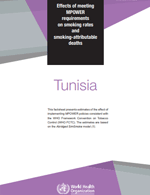
Tunisia: Effects of meeting MPOWER requirements on smoking rates and smoking-attributable deaths
Publication date: 2018
This country factsheet presents estimates of the effect of implementing MPOWER policies consistent with the WHO Framework Convention on Tobacco Control (WHO FCTC). The estimates are based on the Abridged SimSmoke model. The Abridged SimSmoke model has been used to show the number of deaths from smoking and how implementation of MPOWER policies - tax increases accompanied by smoke-free laws, comprehensive marketing restrictions, comprehensive cessation programmes, strong health warnings and mass media campaigns - can reduce smoking prevalence by 2025, thus meeting the global target of a 30% reduction.
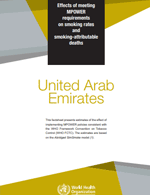
United Arab Emirates: Effects of meeting MPOWER requirements on smoking rates and smoking-attributable deaths
Publication date: 2018
This country factsheet presents estimates of the effect of implementing MPOWER policies consistent with the WHO Framework Convention on Tobacco Control (WHO FCTC). The estimates are based on the Abridged SimSmoke model. The Abridged SimSmoke model has been used to show the number of deaths from smoking and how implementation of MPOWER policies - tax increases accompanied by smoke-free laws, comprehensive marketing restrictions, comprehensive cessation programmes, strong health warnings and mass media campaigns - can reduce smoking prevalence by 2025, thus meeting the global target of a 30% reduction.
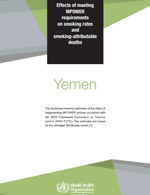
Yemen: Effects of meeting MPOWER requirements on smoking rates and smoking-attributable deaths
Publication date: 2018
This country factsheet presents estimates of the effect of implementing MPOWER policies consistent with the WHO Framework Convention on Tobacco Control (WHO FCTC). The estimates are based on the Abridged SimSmoke model. The Abridged SimSmoke model has been used to show the number of deaths from smoking and how implementation of MPOWER policies - tax increases accompanied by smoke-free laws, comprehensive marketing restrictions, comprehensive cessation programmes, strong health warnings and mass media campaigns - can reduce smoking prevalence by 2025, thus meeting the global target of a 30% reduction.
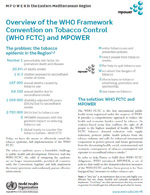
Overview of the WHO Framework Convention on Tobacco Control (WHO FCTC) and MPOWER
Publication date: 2015
The WHO FCTC is the first international public health treaty negotiated under the auspices of WHO. It provides a comprehensive approach to reduce the health and economic burden caused by tobacco. The WHO FCTC balances demand reduction with supply reduction, protects public health policies from the tobacco industry and calls for enhanced international cooperation to protect present and future generations from the devastating health, social, environmental and economic consequences of tobacco consumption and exposure to secondhand tobacco smoke.
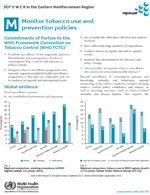
Monitor tobacco use and prevention policies
Publication date: 2015
The MPOWER measures correspond to one or more articles of the Framework Convention on Tobacco Control; to assist in reducing the demand for tobacco products at country-levels. The six components include: monitor tobacco use and prevention policies, protect people from tobacco smoke, offer help to quit tobacco use, warn about the dangers of tobacco, enforce bans on tobacco advertising, promotion and sponsorship and raise taxes on tobacco.
This report highlights the efforts to monitor tobacco use and prevention policies.
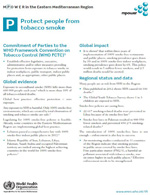
Protect people from tobacco smoke
Publication date: 2015
The MPOWER measures correspond to one or more articles of the Framework Convention on Tobacco Control; to assist in reducing the demand for tobacco products at country-levels. The six components include: monitor tobacco use and prevention policies, protect people from tobacco smoke, offer help to quit tobacco use, warn about the dangers of tobacco, enforce bans on tobacco advertising, promotion and sponsorship and raise taxes on tobacco.
This report highlights the efforts to protect people from tobacco smoke.
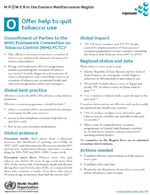
Offer help to quit tobacco use
Publication date: 2015
The MPOWER measures correspond to one or more articles of the Framework Convention on Tobacco Control; to assist in reducing the demand for tobacco products at country-levels. The six components include: monitor tobacco use and prevention policies, protect people from tobacco smoke, offer help to quit tobacco use, warn about the dangers of tobacco, enforce bans on tobacco advertising, promotion and sponsorship and raise taxes on tobacco.
This report highlights the efforts to offer help to quit tobacco use.
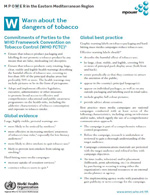
Warn about the dangers of tobacco
Publication date: 2015
The MPOWER measures correspond to one or more articles of the Framework Convention on Tobacco Control; to assist in reducing the demand for tobacco products at country-levels. The six components include: monitor tobacco use and prevention policies, protect people from tobacco smoke, offer help to quit tobacco use, warn about the dangers of tobacco, enforce bans on tobacco advertising, promotion and sponsorship and raise taxes on tobacco.
This report highlights the efforts warn about the dangers of tobacco.
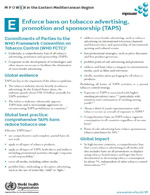
Enforce bans on tobacco advertising, promotion and sponsorship (TAPS)
Publication date: 2015
The MPOWER measures correspond to one or more articles of the Framework Convention on Tobacco Control; to assist in reducing the demand for tobacco products at country-levels. The six components include: monitor tobacco use and prevention policies, protect people from tobacco smoke, offer help to quit tobacco use, warn about the dangers of tobacco, enforce bans on tobacco advertising, promotion and sponsorship and raise taxes on tobacco.
This report highlights the efforts to enforce bans on tobacco advertising, promotion and sponsorship (TAPS).
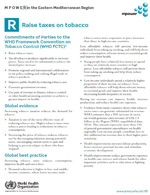
Raise taxes on tobacco
Publication date: 2015
The MPOWER measures correspond to one or more articles of the Framework Convention on Tobacco Control; to assist in reducing the demand for tobacco products at country-levels. The six components include: monitor tobacco use and prevention policies, protect people from tobacco smoke, offer help to quit tobacco use, warn about the dangers of tobacco, enforce bans on tobacco advertising, promotion and sponsorship and raise taxes on tobacco.
This report highlights the efforts to raise taxes on tobacco.
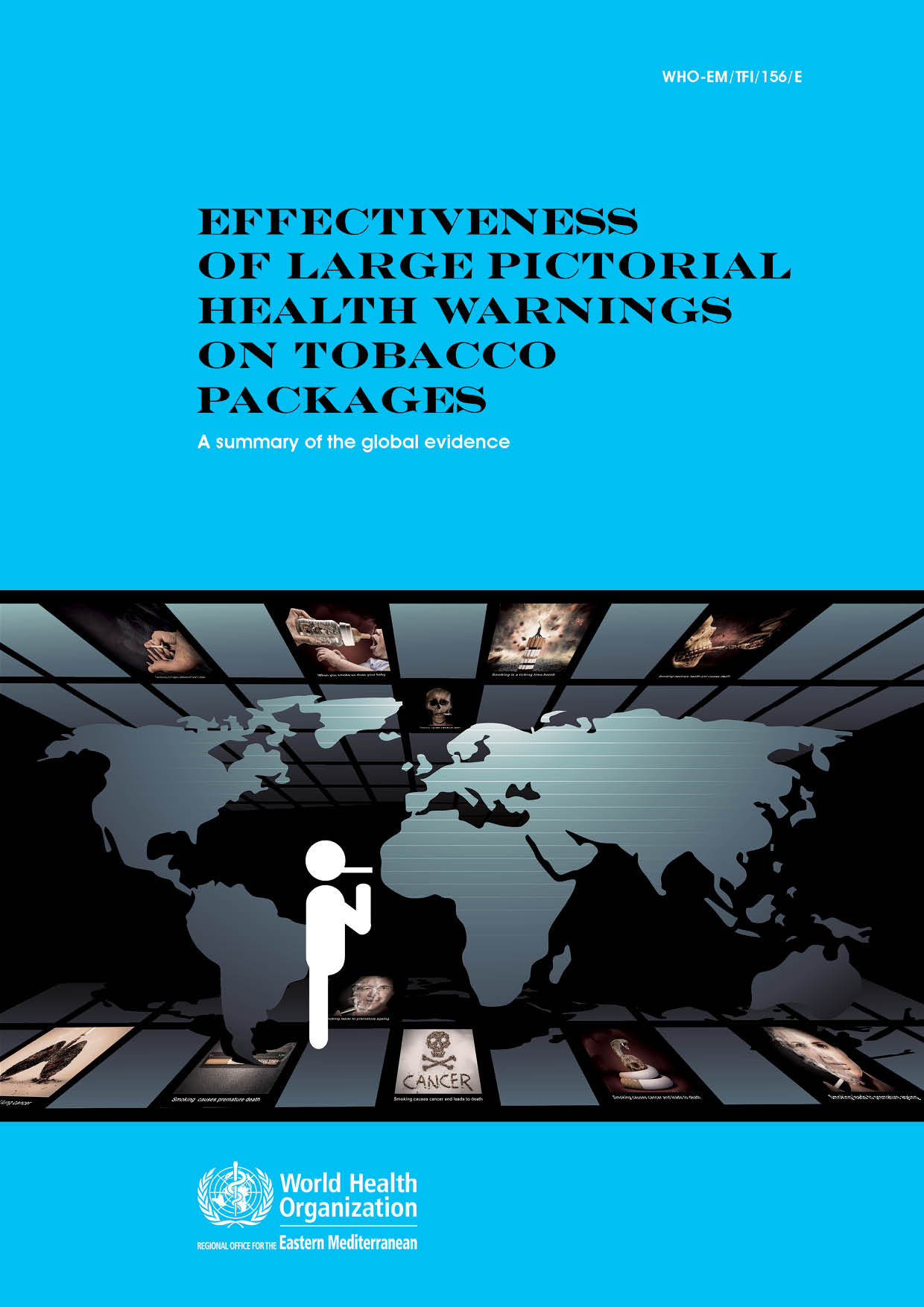
Effectiveness of large pictorial health warnings on tobacco packages: A summary of the global evidence
Publication date: 2018
There is strong and conclusive global evidence that health warning labels are an effective tool for educating the public about the harms of smoking and reducing tobacco consumption and prevalence. This report summarizes global evidence on the use of highly visible pictorial health warnings and the key recommendations to be followed by countries implementing evidence based packaging and labelling measures
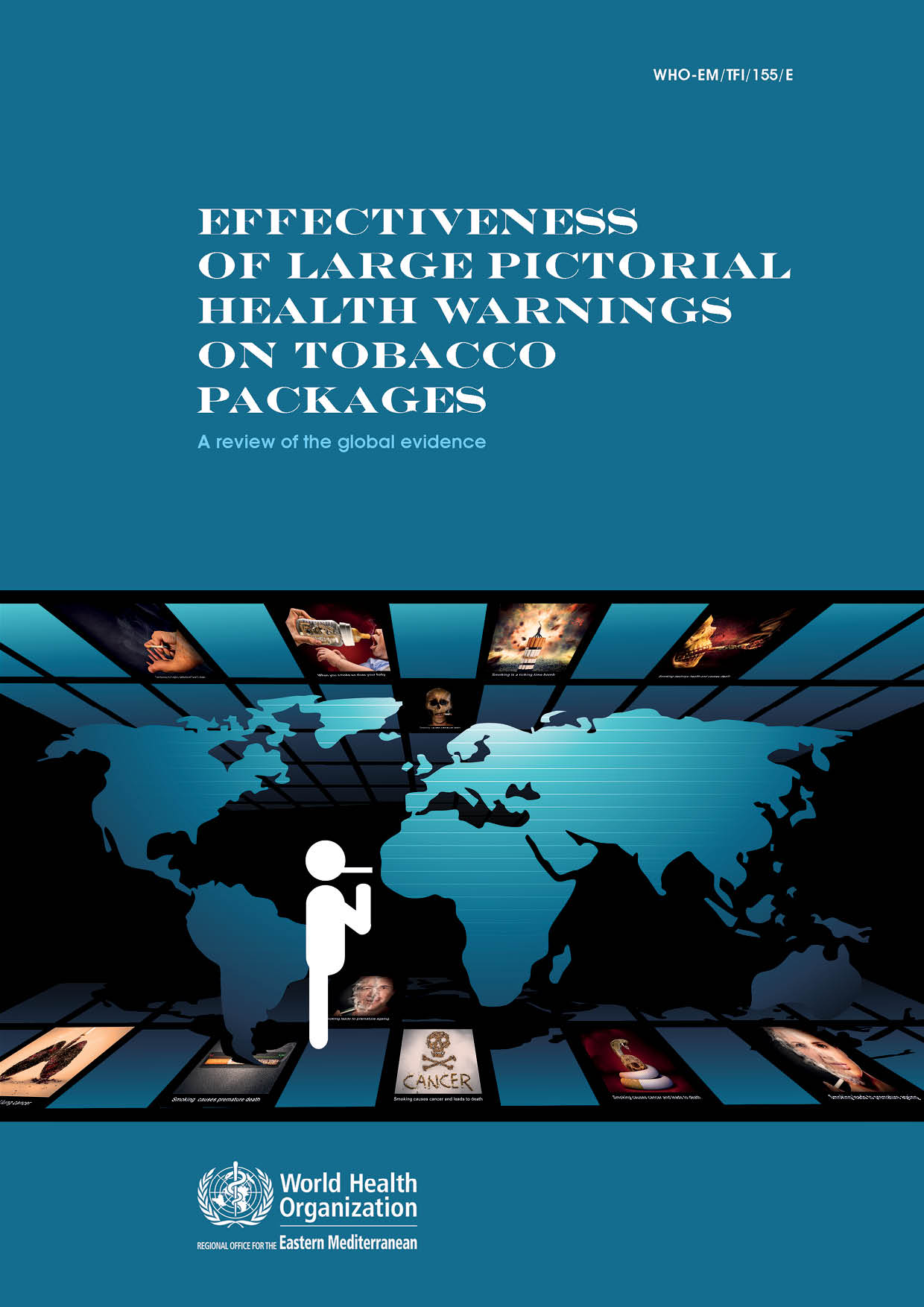
Effectiveness of large pictorial health warnings on tobacco packages: A review of the global evidence
Publication date: 2018
This report presents research evidence on the effectiveness of large pictorial warnings on tobacco product packaging. It is intended to assist policy-makers and key stakeholders in adopting strong, evidence-based tobacco product packaging and labelling measures, in accordance with Article 11 of the WHO FCTC and its guidelines.

Afghanistan: Effects of meeting MPOWER requirements on smoking rates and smoking-attributable deaths
Publication date: 2018
This country factsheet presents estimates of the effect of implementing MPOWER policies consistent with the WHO Framework Convention on Tobacco Control (WHO FCTC). The estimates are based on the Abridged SimSmoke model. The Abridged SimSmoke model has been used to show the number of deaths from smoking and how implementation of MPOWER policies - tax increases accompanied by smoke-free laws, comprehensive marketing restrictions, comprehensive cessation programmes, strong health warnings and mass media campaigns - can reduce smoking prevalence by 2025, thus meeting the global target of a 30% reduction.

Bahrain: Effects of meeting MPOWER requirements on smoking rates and smoking-attributable deaths
Publication date: 2018
This country factsheet presents estimates of the effect of implementing MPOWER policies consistent with the WHO Framework Convention on Tobacco Control (WHO FCTC). The estimates are based on the Abridged SimSmoke model. The Abridged SimSmoke model has been used to show the number of deaths from smoking and how implementation of MPOWER policies - tax increases accompanied by smoke-free laws, comprehensive marketing restrictions, comprehensive cessation programmes, strong health warnings and mass media campaigns - can reduce smoking prevalence by 2025, thus meeting the global target of a 30% reduction.

Egypt: Effects of meeting MPOWER requirements on smoking rates and smoking-attributable deaths
Publication date: 2018
This country factsheet presents estimates of the effect of implementing MPOWER policies consistent with the WHO Framework Convention on Tobacco Control (WHO FCTC). The estimates are based on the Abridged SimSmoke model. The Abridged SimSmoke model has been used to show the number of deaths from smoking and how implementation of MPOWER policies - tax increases accompanied by smoke-free laws, comprehensive marketing restrictions, comprehensive cessation programmes, strong health warnings and mass media campaigns - can reduce smoking prevalence by 2025, thus meeting the global target of a 30% reduction.

Iraq: Effects of meeting MPOWER requirements on smoking rates and smoking-attributable deaths
Publication date: 2018
This country factsheet presents estimates of the effect of implementing MPOWER policies consistent with the WHO Framework Convention on Tobacco Control (WHO FCTC). The estimates are based on the Abridged SimSmoke model. The Abridged SimSmoke model has been used to show the number of deaths from smoking and how implementation of MPOWER policies - tax increases accompanied by smoke-free laws, comprehensive marketing restrictions, comprehensive cessation programmes, strong health warnings and mass media campaigns - can reduce smoking prevalence by 2025, thus meeting the global target of a 30% reduction.

Islamic Republic of Iran: Effects of meeting MPOWER requirements on smoking rates and smoking-attributable deaths
Publication date: 2018
This country factsheet presents estimates of the effect of implementing MPOWER policies consistent with the WHO Framework Convention on Tobacco Control (WHO FCTC). The estimates are based on the Abridged SimSmoke model. The Abridged SimSmoke model has been used to show the number of deaths from smoking and how implementation of MPOWER policies - tax increases accompanied by smoke-free laws, comprehensive marketing restrictions, comprehensive cessation programmes, strong health warnings and mass media campaigns - can reduce smoking prevalence by 2025, thus meeting the global target of a 30% reduction.

Jordan: Effects of meeting MPOWER requirements on smoking rates and smoking-attributable deaths
Publication date: 2018
This country factsheet presents estimates of the effect of implementing MPOWER policies consistent with the WHO Framework Convention on Tobacco Control (WHO FCTC). The estimates are based on the Abridged SimSmoke model. The Abridged SimSmoke model has been used to show the number of deaths from smoking and how implementation of MPOWER policies - tax increases accompanied by smoke-free laws, comprehensive marketing restrictions, comprehensive cessation programmes, strong health warnings and mass media campaigns - can reduce smoking prevalence by 2025, thus meeting the global target of a 30% reduction.

Kuwait: Effects of meeting MPOWER requirements on smoking rates and smoking-attributable deaths
Publication date: 2018
This country factsheet presents estimates of the effect of implementing MPOWER policies consistent with the WHO Framework Convention on Tobacco Control (WHO FCTC). The estimates are based on the Abridged SimSmoke model. The Abridged SimSmoke model has been used to show the number of deaths from smoking and how implementation of MPOWER policies - tax increases accompanied by smoke-free laws, comprehensive marketing restrictions, comprehensive cessation programmes, strong health warnings and mass media campaigns - can reduce smoking prevalence by 2025, thus meeting the global target of a 30% reduction.

Lebanon: Effects of meeting MPOWER requirements on smoking rates and smoking-attributable deaths
Publication date: 2018
This country factsheet presents estimates of the effect of implementing MPOWER policies consistent with the WHO Framework Convention on Tobacco Control (WHO FCTC). The estimates are based on the Abridged SimSmoke model. The Abridged SimSmoke model has been used to show the number of deaths from smoking and how implementation of MPOWER policies - tax increases accompanied by smoke-free laws, comprehensive marketing restrictions, comprehensive cessation programmes, strong health warnings and mass media campaigns - can reduce smoking prevalence by 2025, thus meeting the global target of a 30% reduction.

Libya: Effects of meeting MPOWER requirements on smoking rates and smoking-attributable deaths
Publication date: 2018
This country factsheet presents estimates of the effect of implementing MPOWER policies consistent with the WHO Framework Convention on Tobacco Control (WHO FCTC). The estimates are based on the Abridged SimSmoke model. The Abridged SimSmoke model has been used to show the number of deaths from smoking and how implementation of MPOWER policies - tax increases accompanied by smoke-free laws, comprehensive marketing restrictions, comprehensive cessation programmes, strong health warnings and mass media campaigns - can reduce smoking prevalence by 2025, thus meeting the global target of a 30% reduction.

Morocco: Effects of meeting MPOWER requirements on smoking rates and smoking-attributable deaths
Publication date: 2018
This country factsheet presents estimates of the effect of implementing MPOWER policies consistent with the WHO Framework Convention on Tobacco Control (WHO FCTC). The estimates are based on the Abridged SimSmoke model. The Abridged SimSmoke model has been used to show the number of deaths from smoking and how implementation of MPOWER policies - tax increases accompanied by smoke-free laws, comprehensive marketing restrictions, comprehensive cessation programmes, strong health warnings and mass media campaigns - can reduce smoking prevalence by 2025, thus meeting the global target of a 30% reduction.

Oman: Effects of meeting MPOWER requirements on smoking rates and smoking-attributable deaths
Publication date: 2018
This country factsheet presents estimates of the effect of implementing MPOWER policies consistent with the WHO Framework Convention on Tobacco Control (WHO FCTC). The estimates are based on the Abridged SimSmoke model. The Abridged SimSmoke model has been used to show the number of deaths from smoking and how implementation of MPOWER policies - tax increases accompanied by smoke-free laws, comprehensive marketing restrictions, comprehensive cessation programmes, strong health warnings and mass media campaigns - can reduce smoking prevalence by 2025, thus meeting the global target of a 30% reduction.

Pakistan: Effects of meeting MPOWER requirements on smoking rates and smoking-attributable deaths
Publication date: 2018
This country factsheet presents estimates of the effect of implementing MPOWER policies consistent with the WHO Framework Convention on Tobacco Control (WHO FCTC). The estimates are based on the Abridged SimSmoke model. The Abridged SimSmoke model has been used to show the number of deaths from smoking and how implementation of MPOWER policies - tax increases accompanied by smoke-free laws, comprehensive marketing restrictions, comprehensive cessation programmes, strong health warnings and mass media campaigns - can reduce smoking prevalence by 2025, thus meeting the global target of a 30% reduction.

Palestine: Effects of meeting MPOWER requirements on smoking rates and smoking-attributable deaths
Publication date: 2018
This country factsheet presents estimates of the effect of implementing MPOWER policies consistent with the WHO Framework Convention on Tobacco Control (WHO FCTC). The estimates are based on the Abridged SimSmoke model. The Abridged SimSmoke model has been used to show the number of deaths from smoking and how implementation of MPOWER policies - tax increases accompanied by smoke-free laws, comprehensive marketing restrictions, comprehensive cessation programmes, strong health warnings and mass media campaigns - can reduce smoking prevalence by 2025, thus meeting the global target of a 30% reduction.

Qatar: Effects of meeting MPOWER requirements on smoking rates and smoking-attributable deaths
Publication date: 2018
This country factsheet presents estimates of the effect of implementing MPOWER policies consistent with the WHO Framework Convention on Tobacco Control (WHO FCTC). The estimates are based on the Abridged SimSmoke model. The Abridged SimSmoke model has been used to show the number of deaths from smoking and how implementation of MPOWER policies - tax increases accompanied by smoke-free laws, comprehensive marketing restrictions, comprehensive cessation programmes, strong health warnings and mass media campaigns - can reduce smoking prevalence by 2025, thus meeting the global target of a 30% reduction.

Saudi Arabia: Effects of meeting MPOWER requirements on smoking rates and smoking-attributable deaths
Publication date: 2018
This country factsheet presents estimates of the effect of implementing MPOWER policies consistent with the WHO Framework Convention on Tobacco Control (WHO FCTC). The estimates are based on the Abridged SimSmoke model. The Abridged SimSmoke model has been used to show the number of deaths from smoking and how implementation of MPOWER policies - tax increases accompanied by smoke-free laws, comprehensive marketing restrictions, comprehensive cessation programmes, strong health warnings and mass media campaigns - can reduce smoking prevalence by 2025, thus meeting the global target of a 30% reduction.

Sudan: Effects of meeting MPOWER requirements on smoking rates and smoking-attributable deaths
Publication date: 2018
This country factsheet presents estimates of the effect of implementing MPOWER policies consistent with the WHO Framework Convention on Tobacco Control (WHO FCTC). The estimates are based on the Abridged SimSmoke model. The Abridged SimSmoke model has been used to show the number of deaths from smoking and how implementation of MPOWER policies - tax increases accompanied by smoke-free laws, comprehensive marketing restrictions, comprehensive cessation programmes, strong health warnings and mass media campaigns - can reduce smoking prevalence by 2025, thus meeting the global target of a 30% reduction.

Syrian Arab Republic: Effects of meeting MPOWER requirements on smoking rates and smoking-attributable deaths
Publication date: 2018
This country factsheet presents estimates of the effect of implementing MPOWER policies consistent with the WHO Framework Convention on Tobacco Control (WHO FCTC). The estimates are based on the Abridged SimSmoke model. The Abridged SimSmoke model has been used to show the number of deaths from smoking and how implementation of MPOWER policies - tax increases accompanied by smoke-free laws, comprehensive marketing restrictions, comprehensive cessation programmes, strong health warnings and mass media campaigns - can reduce smoking prevalence by 2025, thus meeting the global target of a 30% reduction.

Tunisia: Effects of meeting MPOWER requirements on smoking rates and smoking-attributable deaths
Publication date: 2018
This country factsheet presents estimates of the effect of implementing MPOWER policies consistent with the WHO Framework Convention on Tobacco Control (WHO FCTC). The estimates are based on the Abridged SimSmoke model. The Abridged SimSmoke model has been used to show the number of deaths from smoking and how implementation of MPOWER policies - tax increases accompanied by smoke-free laws, comprehensive marketing restrictions, comprehensive cessation programmes, strong health warnings and mass media campaigns - can reduce smoking prevalence by 2025, thus meeting the global target of a 30% reduction.

United Arab Emirates: Effects of meeting MPOWER requirements on smoking rates and smoking-attributable deaths
Publication date: 2018
This country factsheet presents estimates of the effect of implementing MPOWER policies consistent with the WHO Framework Convention on Tobacco Control (WHO FCTC). The estimates are based on the Abridged SimSmoke model. The Abridged SimSmoke model has been used to show the number of deaths from smoking and how implementation of MPOWER policies - tax increases accompanied by smoke-free laws, comprehensive marketing restrictions, comprehensive cessation programmes, strong health warnings and mass media campaigns - can reduce smoking prevalence by 2025, thus meeting the global target of a 30% reduction.

Yemen: Effects of meeting MPOWER requirements on smoking rates and smoking-attributable deaths
Publication date: 2018
This country factsheet presents estimates of the effect of implementing MPOWER policies consistent with the WHO Framework Convention on Tobacco Control (WHO FCTC). The estimates are based on the Abridged SimSmoke model. The Abridged SimSmoke model has been used to show the number of deaths from smoking and how implementation of MPOWER policies - tax increases accompanied by smoke-free laws, comprehensive marketing restrictions, comprehensive cessation programmes, strong health warnings and mass media campaigns - can reduce smoking prevalence by 2025, thus meeting the global target of a 30% reduction.

Overview of the WHO Framework Convention on Tobacco Control (WHO FCTC) and MPOWER
Publication date: 2015
The WHO FCTC is the first international public health treaty negotiated under the auspices of WHO. It provides a comprehensive approach to reduce the health and economic burden caused by tobacco. The WHO FCTC balances demand reduction with supply reduction, protects public health policies from the tobacco industry and calls for enhanced international cooperation to protect present and future generations from the devastating health, social, environmental and economic consequences of tobacco consumption and exposure to secondhand tobacco smoke.

Monitor tobacco use and prevention policies
Publication date: 2015
The MPOWER measures correspond to one or more articles of the Framework Convention on Tobacco Control; to assist in reducing the demand for tobacco products at country-levels. The six components include: monitor tobacco use and prevention policies, protect people from tobacco smoke, offer help to quit tobacco use, warn about the dangers of tobacco, enforce bans on tobacco advertising, promotion and sponsorship and raise taxes on tobacco.
This report highlights the efforts to monitor tobacco use and prevention policies.

Protect people from tobacco smoke
Publication date: 2015
The MPOWER measures correspond to one or more articles of the Framework Convention on Tobacco Control; to assist in reducing the demand for tobacco products at country-levels. The six components include: monitor tobacco use and prevention policies, protect people from tobacco smoke, offer help to quit tobacco use, warn about the dangers of tobacco, enforce bans on tobacco advertising, promotion and sponsorship and raise taxes on tobacco.
This report highlights the efforts to protect people from tobacco smoke.

Offer help to quit tobacco use
Publication date: 2015
The MPOWER measures correspond to one or more articles of the Framework Convention on Tobacco Control; to assist in reducing the demand for tobacco products at country-levels. The six components include: monitor tobacco use and prevention policies, protect people from tobacco smoke, offer help to quit tobacco use, warn about the dangers of tobacco, enforce bans on tobacco advertising, promotion and sponsorship and raise taxes on tobacco.
This report highlights the efforts to offer help to quit tobacco use.

Warn about the dangers of tobacco
Publication date: 2015
The MPOWER measures correspond to one or more articles of the Framework Convention on Tobacco Control; to assist in reducing the demand for tobacco products at country-levels. The six components include: monitor tobacco use and prevention policies, protect people from tobacco smoke, offer help to quit tobacco use, warn about the dangers of tobacco, enforce bans on tobacco advertising, promotion and sponsorship and raise taxes on tobacco.
This report highlights the efforts warn about the dangers of tobacco.

Enforce bans on tobacco advertising, promotion and sponsorship (TAPS)
Publication date: 2015
The MPOWER measures correspond to one or more articles of the Framework Convention on Tobacco Control; to assist in reducing the demand for tobacco products at country-levels. The six components include: monitor tobacco use and prevention policies, protect people from tobacco smoke, offer help to quit tobacco use, warn about the dangers of tobacco, enforce bans on tobacco advertising, promotion and sponsorship and raise taxes on tobacco.
This report highlights the efforts to enforce bans on tobacco advertising, promotion and sponsorship (TAPS).

Raise taxes on tobacco
Publication date: 2015
The MPOWER measures correspond to one or more articles of the Framework Convention on Tobacco Control; to assist in reducing the demand for tobacco products at country-levels. The six components include: monitor tobacco use and prevention policies, protect people from tobacco smoke, offer help to quit tobacco use, warn about the dangers of tobacco, enforce bans on tobacco advertising, promotion and sponsorship and raise taxes on tobacco.
This report highlights the efforts to raise taxes on tobacco.








